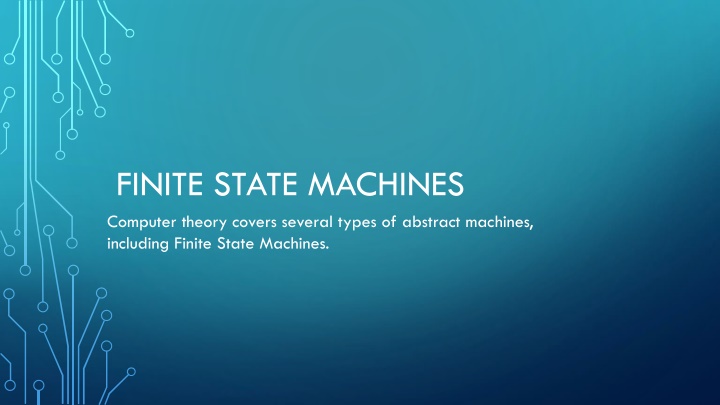
Finite State Machines in Computer Theory
"Learn about Finite State Machines (FSMs), essential components in computer theory that represent abstract machines. Explore different FSM categories, from acceptors to sequencers, and their applications in various systems."
Download Presentation

Please find below an Image/Link to download the presentation.
The content on the website is provided AS IS for your information and personal use only. It may not be sold, licensed, or shared on other websites without obtaining consent from the author. If you encounter any issues during the download, it is possible that the publisher has removed the file from their server.
You are allowed to download the files provided on this website for personal or commercial use, subject to the condition that they are used lawfully. All files are the property of their respective owners.
The content on the website is provided AS IS for your information and personal use only. It may not be sold, licensed, or shared on other websites without obtaining consent from the author.
E N D
Presentation Transcript
FINITE STATE MACHINES Computer theory covers several types of abstract machines, including Finite State Machines.
FINITE STATE MACHINES Also known as Finite State Automata Also known as FSM, or State Machines
FACTS ABOUT FSM, IN GENERAL TERMS Finite State Machines are important part of intelligent systems. The most famous FSM is the Turing Machine, which can represent the logic of almost any computer algorithm. FSMs exist in everything from elevators to traffic lights; from vending machines to combination locks; from credit card number validation to complex artificial intelligence systems.
MAIN FSM CATEGORIES Acceptors Transducers Sequencers
ACCEPTORS Acceptor machines are useful in creating simple grammars. If it is possible to build an FSM to represent a grammar, it is called a regular language. A single acceptor statement in a regular language is called a regular expression. Example: When you learn a new programming language for the first time, you see a sub-language that has syntax rules. Regular expressions are used to define the syntax.
TRANSDUCERS Transducers read input files and generate a corresponding output file. These tools are used to consolidate multiple files into a single large data file. Example: Transducers convert from generic data into a game's final memory format for faster loading time.
SEQUENCERS Sequencer are FSMs are used to control a sequence of events or actions. Example Sequencers can be used to model game behavior.
SEQUENCERS STORE TWO TYPES OF INFORMATION A set of states that represent the scenarios of the game. These are the configurations that the AI will be immersed in. A set of transitions that are conditions that move a behavior from one scenario to another. These scenarios are described as the transition between two states in a directed way. FSM sequencers depict a complete network or collection of possible actions (the states) and ways to change from one action to the other.
EXAMINE A BASIC VIRTUAL PET 1. A pet isHUNGRY. 2. If you provide it with food, the pet isEATING that food, it will not be hungry anymore. 3. After eating (consuming energy calories), the pet isPLAYING. 4. Pet isHUNGRY again after burning calories all the consumed calories during play. Three states are described: isHUNGRY, isEATING, isPLAYING. Statements that describe how and when the states are altered are called transitions.
TRANSITIONS Assume the pet begins in a isHUNGRY state. If the user supplies food, the pet is in the state of isEATING. If food is consumed and the stomach is full, the pet will transition into the isPLAYING state. A pet is always in one of a finite number of states. A Transition is based on two things: the current state, and actions and conditions.
FSM: VIRTUAL PET Note: A dead pet cannot be revived.
IMPLEMENTATION Use a switch statement. Each of the cases in the switch controls a specific state and evaluates the possibility of changing states due to a specific transition in the automata being selected. Each state's activities can be divided into specific areas: a. The name of the state b. The default actions to be carried out in that state c. The calculations to perform in order to evaluate outgoing transitions
const isHUNGRY:int = 1; const isEATING:int = 2; var state:int; switch (state) { case isHUNGRY: // default actions to be carried out when the pet is hungry break; case isEATING: // default actions to be carried out when the pet is eating break; . . . }
